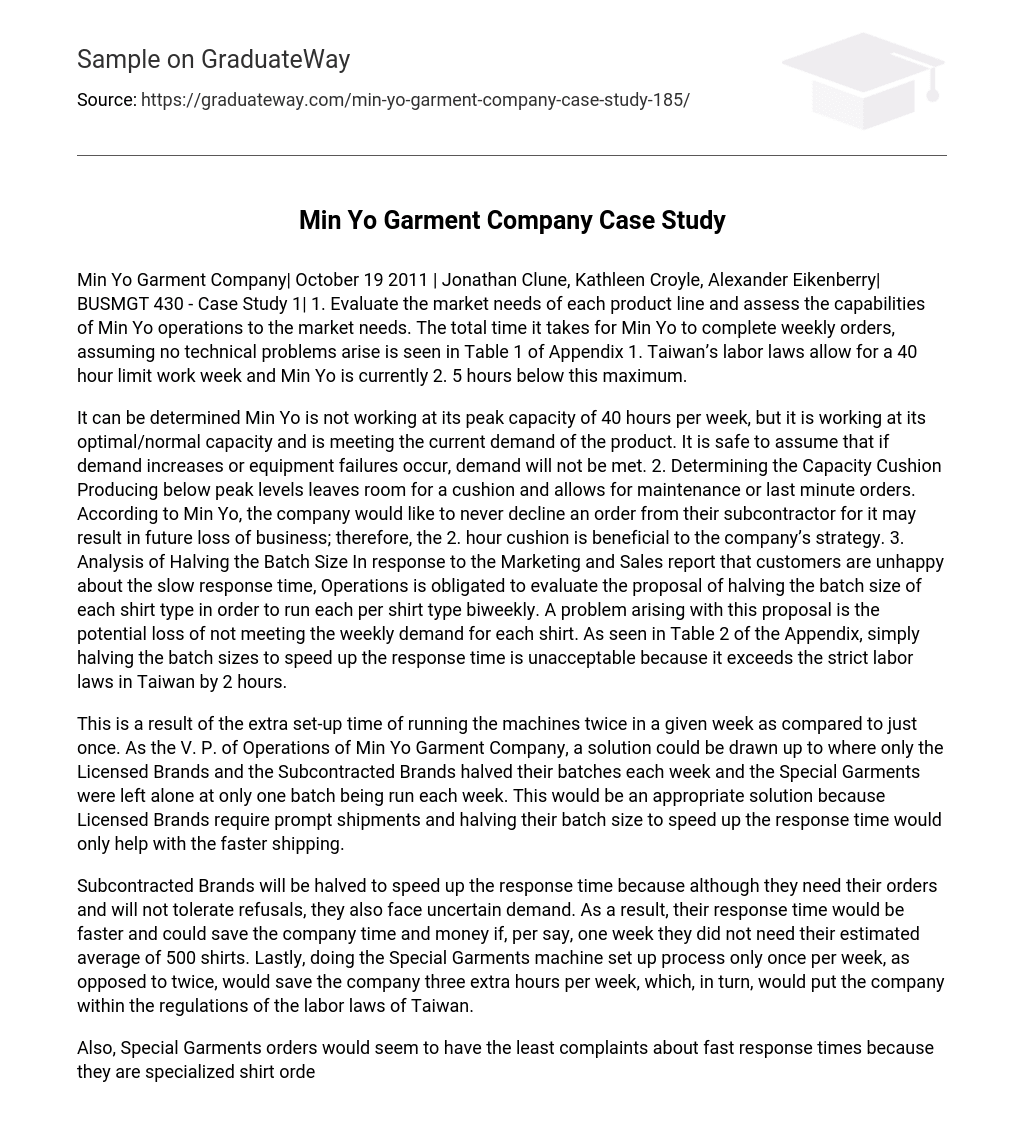Determining the Capacity Cushion
Producing below peak levels leaves room for a cushion and allows for maintenance or last minute orders. According to Min Yo, the company would like to never decline an order from their subcontractor for it may result in future loss of business; therefore, the 2. hour cushion is beneficial to the company’s strategy.
Analysis of Halving the Batch Size
In response to the Marketing and Sales report that customers are unhappy about the slow response time, Operations is obligated to evaluate the proposal of halving the batch size of each shirt type in order to run each per shirt type biweekly. A problem arising with this proposal is the potential loss of not meeting the weekly demand for each shirt.
This is a result of the extra set-up time of running the machines twice in a given week as compared to just once. As the V. P. of Operations of Min Yo Garment Company, a solution could be drawn up to where only the Licensed Brands and the Subcontracted Brands halved their batches each week and the Special Garments were left alone at only one batch being run each week. This would be an appropriate solution because Licensed Brands require prompt shipments and halving their batch size to speed up the response time would only help with the faster shipping.
Subcontracted Brands will be halved to speed up the response time because although they need their orders and will not tolerate refusals, they also face uncertain demand. As a result, their response time would be faster and could save the company time and money if, per say, one week they did not need their estimated average of 500 shirts.
Lastly, doing the Special Garments machine set up process only once per week, as opposed to twice, would save the company three extra hours per week, which, in turn, would put the company within the regulations of the labor laws of Taiwan. Also, Special Garments orders would seem to have the least complaints about fast response times because they are specialized shirt orders that are placed and only accepted if Min Yo is able to complete the order.
Consulting Recommendations to Improve the Business Set-Up or Changeover Reduction Project (Dragon Shirts)
One of the key issues currently limiting the manufacturing processes at Min Yo is 3 and 1 hour set up times seen in the changeovers of Dragon Shirts and Thunder Shirts, respectively. The two changeover times are seen as bottlenecks in the system and cause Min Yo to lose approximately 4 hours of production time during the changeovers. Min Yo should target the elimination of getting supplies, setting up machinery, filling out paperwork and any other Non-Value Added activity when looking at ways to decrease set-up times.
Through the reduction of set-up time, Min Yo will improve utilization, increase capacity, and create more volume; all three changes bring more value to the process and will help Min Yo handle the increasing demand of many of their products. By reducing the set-up times of the current products, Min Yo can now set out to reduce the batch sizes of each shirt type. Large batch sizes are responsible for creating high levels of work-in-process, high manufacturing lead times, large inventory of finished goods and ultimately could lead to poor quality and throughput.
Batch size reduction may increase the number of changeovers but ultimately the project will result in a level loaded production flow that increases the delivery of supplies internally and reduces Min Yo’s risk of scrapping out 900 shirts with poor quality. Overall, Min Yo will be able to efficiently produce to the customers’ demands through EOQ Models and will not have to take on the extra costs of carrying large amounts of work in process and finished goods.
After targeting the key problems of long set-up times and large batch sizes, Min Yo can begin taking a more in depth look at the company’s long term strategic plan. Currently producing three different product families, Min Yo is going to be faced with many business decisions that could set them down the wrong paths. With capacity currently at 37. 5 hours, Min Yo only has 2. 5 hours available to account for new increases in demand or other issues that decrease the availability of the machine.
As demand for shirts increases and business continues to grow, Min Yo will be faced with answering the following questions: How does Min Yo increase capacity at the Garment Maker? In order to answer the above question Min Yo must further align their strategic plan to take into account the addition of more shift, machines, operators or new technology to decrease shirt run times within their manufacturing processes. A strategic plan can focus largely on manufacturing and technology or can also target areas of operation such as sustainability.
Does Min Yo look into eliminating product types and concentrate on other markets? The markets for licensed, subcontracted brands and special garments will continue to change. Min Yo must develop a strategy that will account for each one of the product markets and change in demands. If the strategy is to produce only licensed brands, Min Yo would establish themselves as a low cost, low mix, and high volume supplier; however, if the strategy is to produce only special garments, Min Yo would be known as a high cost, high mix, and low volume supplier.





